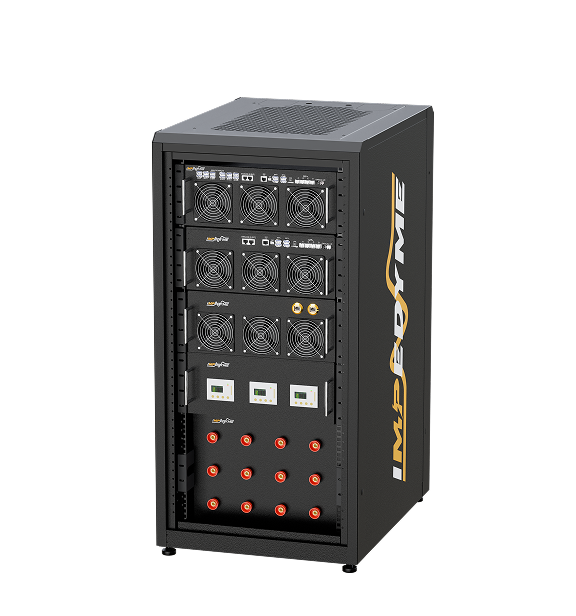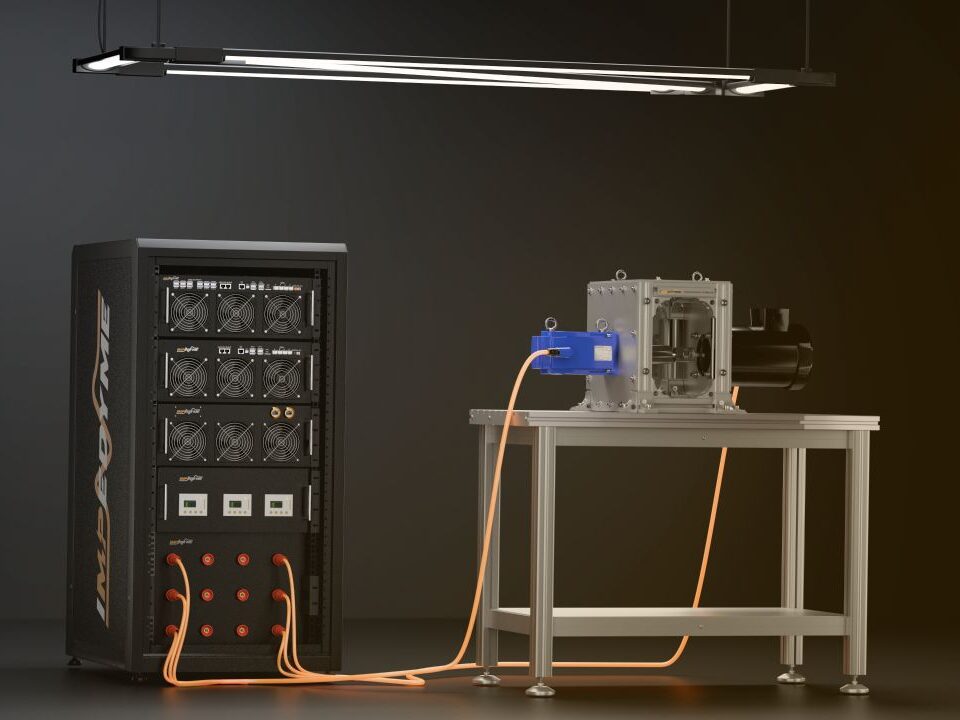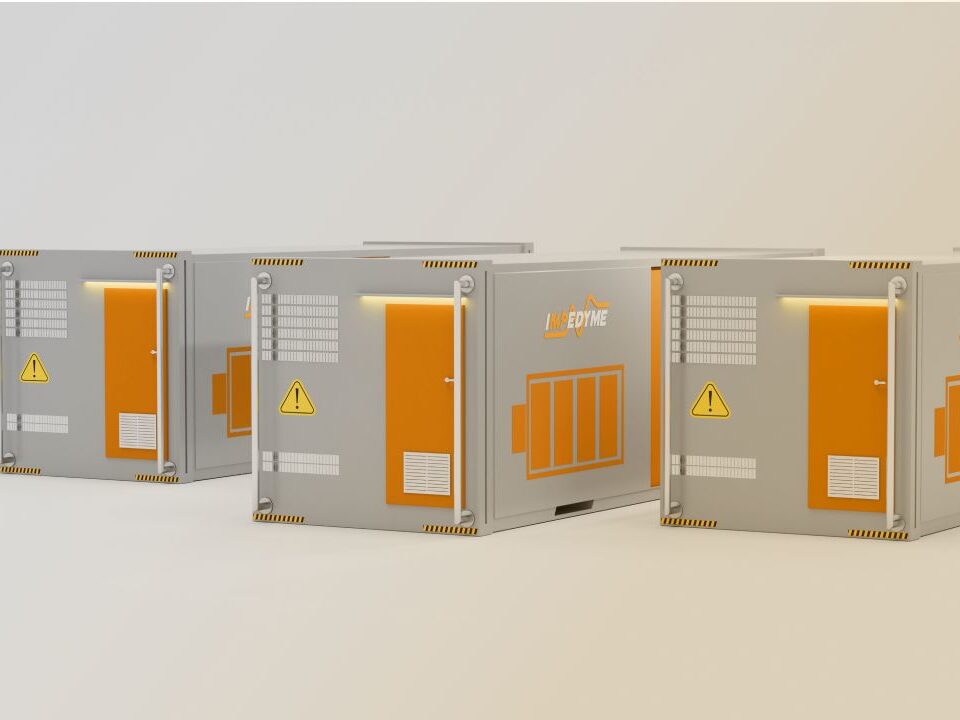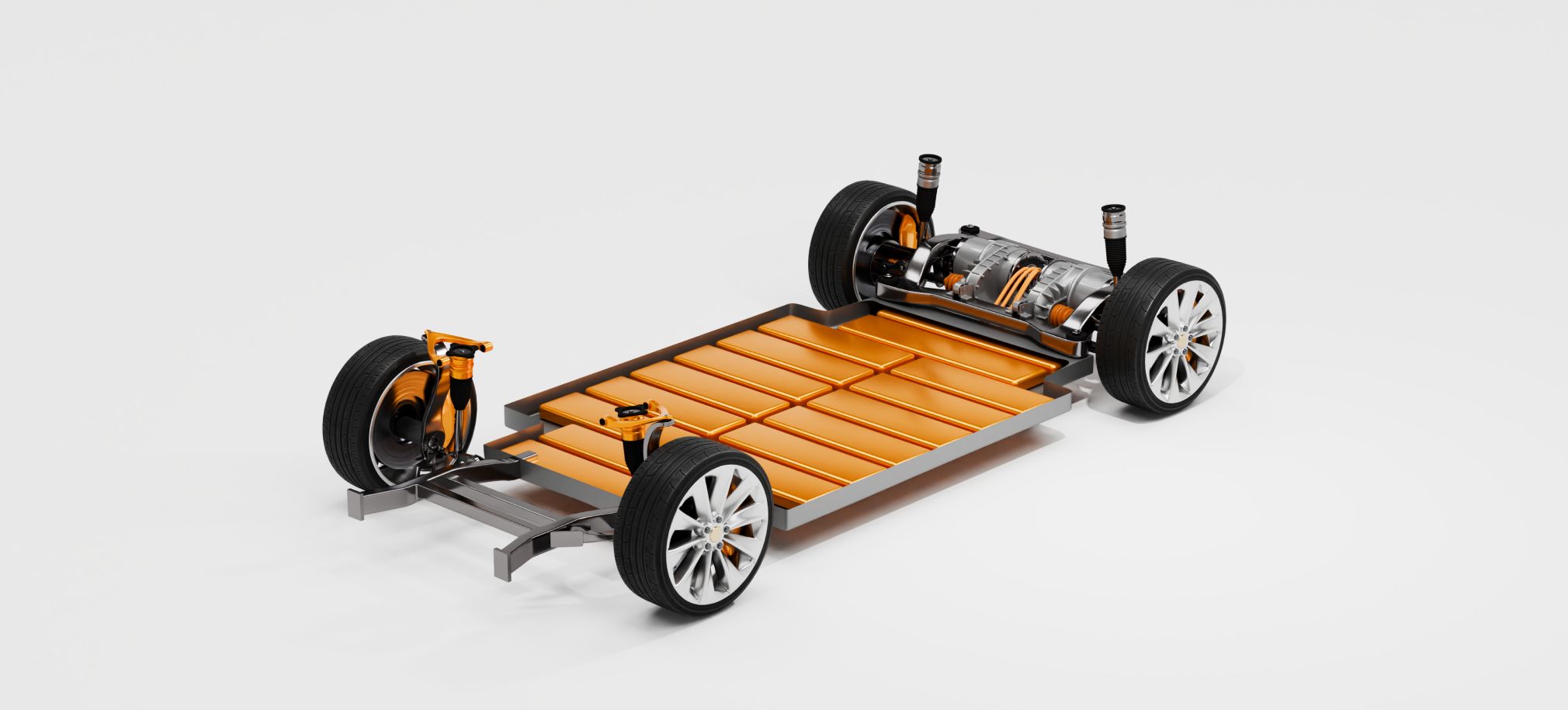
-
 Induction Motor
Induction Motor
-
 Automotive Electrical System Simulation
Automotive Electrical System Simulation
-
 DC/DC Bidirectional Converter
DC/DC Bidirectional Converter
-
 PWM Control for Brushless DC
PWM Control for Brushless DC
-
 BLDC Motor Control and Drive Simulation
BLDC Motor Control and Drive Simulation
-
 Electric Vehicle Fast Charger Simulation
Electric Vehicle Fast Charger Simulation
-
 DFIG Wind Turbine Simulation
DFIG Wind Turbine Simulation
-
 Dual Active Bridge
Dual Active Bridge
-
 EV Dynamometer Test Environment Simulation
EV Dynamometer Test Environment Simulation
-
 Electric Vehicle Simulation
Electric Vehicle Simulation
-
 Three-Phase Grid-Connected Inverter Using Direct-Q…
Three-Phase Grid-Connected Inverter Using Direct-Q…
-
 Three-Phase Grid-Connected Solar Photovoltaic
Three-Phase Grid-Connected Solar Photovoltaic
-
 Grid-Connected Rectifier
Grid-Connected Rectifier
-
 Grid-Tied Inverter System
Grid-Tied Inverter System
-
 Torque Control in a Hybrid Excitation Synchronous …
Torque Control in a Hybrid Excitation Synchronous …
-
 Wye-Delta Starting Circuit
Wye-Delta Starting Circuit
-
 IPMSM-Based Axle-Drive
IPMSM-Based Axle-Drive
-
 Simplified Parallel Hybrid Electric Vehicle
Simplified Parallel Hybrid Electric Vehicle
-
 Simplified Series Hybrid Electric Vehicle
Simplified Series Hybrid Electric Vehicle
-
 Series-Parallel Hybrid Electric Vehicle
Series-Parallel Hybrid Electric Vehicle
-
 Three-Phase Matrix Converter Simulation
Three-Phase Matrix Converter Simulation
-
 Venturini Modulation for Three-Phase Matrix Conver…
Venturini Modulation for Three-Phase Matrix Conver…
-
 Microgrid Frequency Regulation Using Vehicle-to-Gr…
Microgrid Frequency Regulation Using Vehicle-to-Gr…
-
 Three-Phase Modular Multilevel Converter
Three-Phase Modular Multilevel Converter
-
 Field-Oriented Control
Field-Oriented Control
-
 Interior Permanent Magnet Synchronous Generator
Interior Permanent Magnet Synchronous Generator
-
 Permanent Magnet Synchronous Machine
Permanent Magnet Synchronous Machine
-
 PMSM Rotor Angular Velocity
PMSM Rotor Angular Velocity
-
 PMSM-Based Electrical Traction Drive
PMSM-Based Electrical Traction Drive
-
 Maximum Power Point Tracking
Maximum Power Point Tracking
-
 Six-Phase Permanent Magnet Synchronous Machine
Six-Phase Permanent Magnet Synchronous Machine
-
 Synchronous Machine-Based Electrical Drive Simulat…
Synchronous Machine-Based Electrical Drive Simulat…
-
 Single-Stage Solar Inverter
Single-Stage Solar Inverter
-
 Three-Phase Cycloconverter Simulation
Three-Phase Cycloconverter Simulation
-
 Totem-Pole PFC Simulation
Totem-Pole PFC Simulation
-
 Twelve-Pulse Thyristor Rectifier
Twelve-Pulse Thyristor Rectifier
-
 Two-Wheeler On-Board Charger
Two-Wheeler On-Board Charger
-
 Vienna Rectifier Simulation
Vienna Rectifier Simulation
-
 High-Voltage Direct Current
High-Voltage Direct Current
-
 Wireless Power Transfer
Wireless Power Transfer

Comprehensive Documentation for Three-Phase Matrix Converter Simulation
Table of Contents
- 1 Comprehensive Documentation for Three-Phase Matrix Converter Simulation
- 1.1 Introduction
- 1.2 System Overview
- 1.2.1 What is a Matrix Converter?
- 1.2.2 Purpose of the Simulation
- 1.2.3 How Impedyme HIL/PHIL Adds Value
- 1.3 Key Features
- 1.3.1 Unity Power Factor Operation
- 1.3.2 Bidirectional Power Flow Control
- 1.3.3 Seamless Frequency and Voltage Conversion
- 1.4 Simulation Objectives
- 1.5 Technical Description
- 1.5.1 System Configuration
- 1.5.2 Control Methodology
- 1.5.3 Advantages of Matrix Converters
- 1.6 Applications
- 1.7 Simulation Benefits
- 1.8 Summary
- 1.9 Future Enhancements
- 1.9.1 Induction Motor
- 1.9.2 Automotive Electrical System Simulation
- 1.9.3 DC/DC Bidirectional Converter
- 1.9.4 PWM Control for Brushless DC
Introduction
The Three-Phase Matrix Converter Simulation is a detailed model designed to demonstrate direct AC-AC power conversion using a matrix converter topology. This innovative approach eliminates the need for intermediate DC energy storage, offering a compact and efficient solution for driving static loads. The simulation falls under Power Transmission, showcasing its importance in modern power systems where direct energy transfer is critical for performance and cost optimization.
Impedyme’s Role in the Process With Impedyme’s advanced HIL and PHIL solutions, the development and validation of this matrix converter system can be streamlined. From early-stage control algorithm design to real-time hardware validation, Impedyme platforms ensure the entire lifecycle of the matrix converter can be tested efficiently and reliably in both signal-level and power-level environments.
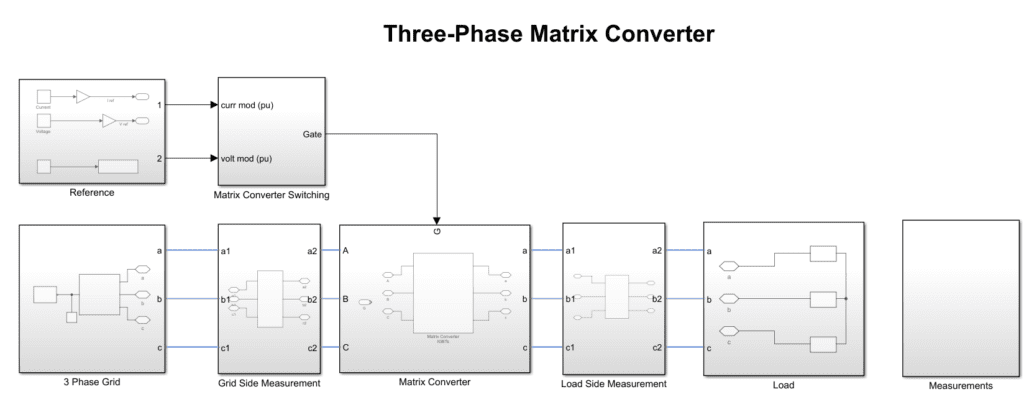
System Overview
What is a Matrix Converter?
A matrix converter directly connects the three-phase input to the three-phase output using an array of bidirectional switches. This removes the need for intermediate DC storage, reducing size and improving efficiency. However, precise control of the switching devices is crucial for reliable operation, especially under real-world grid and load disturbances.
Purpose of the Simulation
The simulation aims to:
- Demonstrate direct AC-AC conversion principles.
- Validate power factor correction and frequency conversion capabilities.
- Analyze efficiency, power quality, and control strategies.
How Impedyme HIL/PHIL Adds Value
Rapid Control Prototyping (RCP): Develop and test control algorithms for switching logic, power factor correction, and frequency conversion directly in Impedyme’s HIL platform before deploying to hardware.
HIL for Power Electronics Controllers: The control logic for the matrix converter can be tested in real-time with a simulated grid and load, ensuring it performs correctly in software-in-the-loop (SIL) and controller-in-the-loop (CIL) stages.
PHIL Testing: The final converter hardware can be tested at power level, interacting with a realistic AC grid and load, ensuring safe and reliable performance before field deployment.
Key Features
Unity Power Factor Operation
The matrix converter achieves unity power factor by adjusting its switching strategy to match the input voltage and current phases.
➡️ HIL/PHIL Benefit: Real-time grid emulation using Impedyme’s PHIL allows testing how the converter maintains unity power factor under various grid conditions (voltage sags, frequency variations, harmonics).
Bidirectional Power Flow Control
The converter supports power flow in both directions, enabling energy recovery (regenerative braking) and operation in both motor and generator modes.
➡️ HIL/PHIL Benefit: Impedyme platforms can emulate both the grid and load, allowing comprehensive verification of bidirectional power transfer in realistic conditions.
Seamless Frequency and Voltage Conversion
The converter can deliver any desired output frequency and voltage within the limits imposed by the input source, enabling integration into flexible industrial processes.
➡️ HIL/PHIL Benefit: With Impedyme’s programmable grid simulators, various input conditions (50Hz, 60Hz, voltage dips, harmonic distortion) can be applied in real time, ensuring the matrix converter handles diverse environments correctly.
Simulation Objectives
This simulation helps evaluate:
- Direct AC-AC conversion quality
- Switching strategy effectiveness
- Input power factor correction
- Power transfer efficiency ➡️ HIL/PHIL Benefit: These evaluations can be performed not just in simulation, but also in hardware testing environments using Impedyme’s platforms, allowing correlation between model predictions and real hardware behavior.
Technical Description
System Configuration
Input: Three-phase AC supply (grid or generator)
Output: Three-phase AC load (static load – resistive, inductive)
Power Stage: 3×3 matrix of bidirectional switches (IGBTs, MOSFETs, or SiC devices)
Control Methodology
Direct Transfer Function or Space Vector Modulation (SVM) to generate switching signals.
Control goals: maintain output quality, ensure unity power factor at input, minimize harmonics.
➡️ HIL/PHIL Benefit: The control logic can be tested via RCP on Impedyme’s HIL platform, and the actual power stage can be verified under real power using PHIL, ensuring smooth transition from simulation to hardware.
Advantages of Matrix Converters
One of the key advantages of matrix converters is their compact size.
Not only are matrix converters smaller in size, but they are also more reliable.
Another advantage of matrix converters is their ability to achieve sinusoidal grid currents. Another advantage of matrix converters is their ability to achieve sinusoidal grid currents.
Additionally, matrix converters provide a completely controllable power factor. Even if the load is an induction motor drawing reactive power from the system, the switches can be controlled in such a way that the grid does not perceive any reactive power being drawn. This allows the system to operate at a unity power factor.
Furthermore, matrix converters can function as compensators, drawing leading VARs from the system to compensate for other lagging loads. This means the power factor of the currents drawn from the grid can be unity, leading, or lagging, making the input power factor fully controllable.
Other advantages have also been explored recently, such as the possibility of eliminating common-mode voltage. However, discussing this in detail would go beyond the current discussion.
➡️ HIL/PHIL Benefit: Each of these features can be validated across the full development cycle (RCP → HIL → PHIL) using Impedyme’s solutions.
Applications
Motor Drives: Industrial motors requiring variable frequency
Renewables: Direct grid connection of AC generators (wind, ocean)
Aerospace Power Systems: Compact frequency conversion
Microgrids: Flexible AC-AC conversion for DER integration
Marine Power: Frequency conversion for ships with multiple sources
➡️ HIL/PHIL Benefit: All these applications can be emulated and tested in real-time using Impedyme platforms, accelerating the development of tailored solutions for each case.
Simulation Benefits
With this simulation, users can:
- Explore matrix converter dynamics in detail.
- Test advanced control algorithms.
- Assess input/output power quality.
- Evaluate transient behavior under grid/load changes.
➡️ HIL/PHIL Benefit: These insights can be directly translated to hardware using Impedyme’s PHIL, ensuring your real device meets its design targets.
Summary
The Three-Phase Matrix Converter Simulation demonstrates a cutting-edge AC-AC conversion approach, replacing conventional rectifier-inverter pairs with direct switching matrices. Combined with Impedyme’s HIL and PHIL solutions, the entire development workflow is streamlined:
Development Stage Impedyme’s Contribution Control Design RCP using HIL for rapid algorithm validation Control Hardware Testing CIL with real-time matrix converter models Power Stage Verification PHIL with real voltage and power interaction Final Validation Full-system PHIL under realistic grid and load conditions.
Future Enhancements
Integration of grid codes and compliance testing in PHIL.
Advanced modulation for harmonic minimization.
Fault-tolerant control verification under faulted switch conditions.
Integration with renewable generators for real-world microgrid scenarios.
The combination of a Three-Phase Matrix Converter Simulation and Impedyme’s HIL/PHIL platforms delivers a seamless development workflow — from concept to control validation, to power-level testing. This comprehensive approach ensures faster time-to-market, reduced design risks, and improved system reliability for next-generation power conversion systems.
